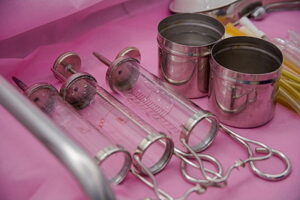
You should be glad you don’t live in the days of antiquity when it comes to healthcare. One can only imagine what techniques they had to use.
Let’s just say you wouldn’t want to get a toothache or your tonsils taken out during this period. Take a look at the photo on the left and you get the idea!
So now we’ll take a look at what people utilized (and some are still used today) to help people with medical problems back in the day.
Ancient Egypt
One of the first civilizations to deviate from the ‘medicine men’ and seek actual ‘doctors’ that could help those who were ailing was the Egyptians. Although they were referred to as doctors (Egyptians who specialized in healing human illnesses), they concentrated mainly on potions to cure their illnesses.
Information related to Egyptian physicians dates back as far as 2600 BC when King Zozer had a doctor who was very well respected and Iraj, who was the physician to the court of pharaohs around 1500 BC.

During this time period, these potion doctors gradually began to develop an understanding of the human body and began more detailed and thorough research.
Archeologists were able to assemble this information via hieroglyphics and papyrus writings, which are documents that were created from papyrus plants.
One of the most intriguing discoveries was the Papyrus Ebers. An Egyptian medical manuscript of herbal knowledge that was written entirely on papyrus paper and dates back to 1550 BC. It contains much information regarding the Egyptian interpretation of the anatomy of the human body.
Although Egyptians could be considered the original civilization to take knowledge of the human body, they still believed that many of the diseases were from spirits.
The Middle Ages
The Middle Ages is the period in Europe that followed the collapse of Roman civilization in the 5th century up to the period of the Renaissance, beginning around the 13th century.
Scholars have researched historical artifacts of how doctors cared for their patients during this period and the instruments they used were crude to say the least. Below are two tools that were used during this time to help the physically ill.
Bullet Extractor
This tool was used to remove bullets or other objects that were inserted into the body due to accident or intentionally from firearms. As these types of ballistic weapons were becoming more popular to fight wars, medical doctors were working feverishly to find ways to help the wounded.
The extractor was a rod with a turn screw that could be adjusted to size in order to capture and clasp the bullet and pull it out.
Arrow Remover
This was designed with a similar extraction method as the bullet extractor but used to remove arrows. There is not a lot of information from research done for this device, but no doubt it was created before the bullet extractor was.
Medical Equipment of the 18th Century
The ‘Antique Brass Nursing Breast Shield’ was a unique device used to cover the breasts of a nursing mother in order to protect her breast and nipples from inflammation and/or soreness.
When there was no other choice but to remove a limb, the ‘Amputation Knife’ was the primary tool that was used. Of course, with today’s medical technology, the whole process of amputation would probably be avoided, but not in the 1700s where many more diseases were prominent among the population.
The practice was to remove the infected limb with this knife and then leave a part of the remaining skin to cover the wound.
For operations, a slightly more sophisticated tool called ‘The Scarificator’ was used. It had 14 blades under the tool’s surface and when brought to the patient, the blades would release to open the skin and the medical procedure would begin.
Medical Equipment of the Early 20th Century

The 20th century witnessed a revolution of advanced medical technology, not to mention it was a time that was benefiting from the industrial revolution.
Advances not only in medicine but in math, physics, engineering, and electronics began to materialize. This took society out of the ‘dark ages’, especially in the medical field, and allowed us to live more comfortably and be able to survive through more ethical and less painful medical procedures.
But in the early years of the century, old 19th century and even 18th-century techniques and equipment were still being used. Some of these procedures and equipment are mentioned below.
For those with external hemorrhoid problems, this 1900 device called hemorrhoid forceps was the medical tool of choice. It was used to damage the hemorrhoidal tissue so that it would not return. Internal hemorrhoids required a more coarse method of hooks and scissors.
Dr. Dettweiler, a physician in the 1910 time period developed a Pocket Spittoon used for patients who had coughing issues. They would spit into the jar and were used by Dr. Dettweiler to research tuberculosis with the hope of containing the spread of this contagious disease.

In the 1920s, we saw a device that was used to remove defective veins. It was called Allen and Hanburys Varicose Vein Strippers and consisted of a flexible wire that would be moved up the vein. Then the vein was removed by pulling on the other end of the wire. Not a very classy method of operation, indeed.
